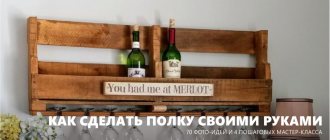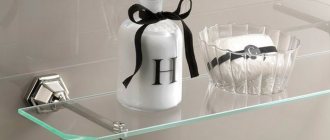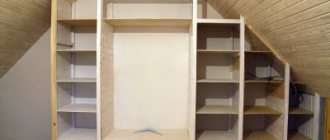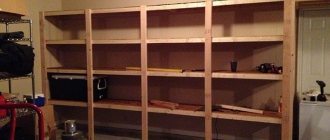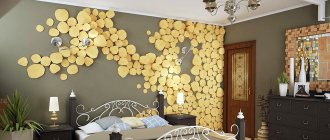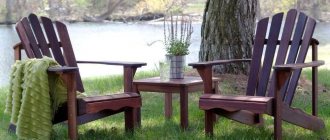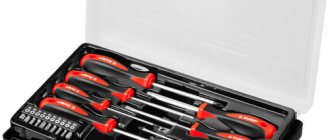In the article “Beautiful Storage of Spices,” we told you how to organize your spice storage system and give it a beautiful and tidy look, so that many different jars and bags do not spoil the overall impression of the kitchen. One of the most convenient and rational storage options is special shelves. We decided to collect interesting and beautiful DIY ideas, inspired by which you can make spice racks with your own hands.
Shelf for spices made of plywood and furniture board
To make such a spacious shelf to your size, you will need 3 mm thick plywood, boards or furniture board, 2 screws, a screwdriver or drill, Moment Joiner glue for wood, sandpaper, and a jigsaw. From a board or furniture panel you need to cut out and sand well 3 load-bearing parts: 2 side walls and a bottom. 4 shelves and 1 transverse strip are cut out of plywood to make the structure stronger. Grooves for shelves are cut into the side walls and cross board. The thickness of the plywood is 3 mm, but the cuts need to be made 3.5 mm wide so that the shelves can be inserted freely. Holes are carefully drilled for 2 screws: if you try to screw in the screws without first drilling the holes, the board or shield may crack. The side walls are connected to the bottom using 2 screws.
After this, the entire structure is assembled to finally make sure that everything is in order. If everything is fine, we disassemble the shelf and start gluing it. Glue is applied to the joints of the parts in the grooves, after which the structure is reassembled. To prevent the side walls from spreading out to the sides, the top of the shelf can be tied with thread until the glue dries (about 15-20 minutes). The resulting product can be painted, varnished or decorated in any other way to your taste: for example, apply beautiful designs using decoupage so that the shelf fits seamlessly into a Provence-style kitchen.
In a drawer
If the drawer does not have a built-in divider, you can find ready-made spice storage devices in the store. They can be wooden or plastic. Spice jars are placed horizontally, allowing them to stay in place when opened. You can do without special accessories: to do this, you need to line the bottom of the drawer with an anti-slip coating, otherwise the spice jars will lie chaotically.
In some kitchen sets, the usable area is used to the maximum, resulting in narrow drawers. It is convenient to store spices in them, since the containers take up little space.
Magnetic holder for glass jars
It is very convenient to place glass jars with spices directly on the wall using magnets and a metal sheet.
A sheet of metal is firmly attached to the wall, and two round magnets are glued to each jar, and that’s it - the most convenient solution for storing seasonings is ready! If you don’t really like the idea of decorating a wall with a sheet of metal, you can decorate it with vinyl film or vinyl wallpaper, after first checking the attracting ability of magnets through a layer of decorative material.
Storage rules
In order for spices to retain their properties for as long as possible, the following conditions must be observed:
- Spices should be stored at room temperature. A strong change in temperature will not benefit them. Therefore, storage areas for spices should be located away from heat sources, including stoves and heating radiators.
- Humidity is a parameter that also affects shelf life. In the case of spices, moisture is not allowed at all. Keep spices away from places where moisture evaporates, including the stove where cooking is taking place. And don't pour seasonings directly from the container into the container. Moisture evaporating from hot dishes enters the packaging and causes gradual deterioration of the spice. In such cases, always use a dry spoon or knife.
- Direct sunlight is good for spices as long as they are growing on the ground. The sun will damage already dry spices. Storage should be either in opaque containers or inside locked cabinets and drawers, or simply away from direct sunlight.
- Glass containers or packaging are preferable. Jars made of ceramics and stainless steel are allowed. Plastic packaging is not recommended. Any type of container must have a hermetically sealed lid.
- Remember that whole spices last much longer than ground spices. Therefore, purchase already ground seasonings in small quantities. Or grind just before use in the required volume and nothing more.
Advice! Once or twice a year, audit all your spice supplies. Throw away those that have lost their usefulness mercilessly. A spoiled spice can be immediately seen by its changed color and smell.
Shelf life of whole spices and herbs: leaves and flowers – 1-2 years, seeds – 2-3 years, root vegetables – 3 years. Shelf life for ground spices: leaves, flowers and seeds - 1 year, root vegetables - 2 years. This is taking into account that all the above storage rules are followed.
Neat wooden shelf
This wonderful shelf for identical round jars of seasonings is also easy to make from 7 narrow boards and a sheet of plywood for the back wall.
To make the shelf look beautiful in the kitchen, you can paint it to match the color of the apron or furniture, and to quickly find seasonings, stick neat labels on the lids of the jars.
Preparing your desktop
First of all, you need to prepare your table on which you will work. There should be no unnecessary things on it and every tool should be at hand. Not everyone has their own desktop and has probably already thought about creating one. Making a table is not difficult, but choosing a place for it in the house is difficult. The ideal option is an insulated balcony, on which you can do crafts at any time. I have already written about preparing the table in a separate article and tried to describe in as much detail as possible the entire process of creating it. If you don’t know how to prepare your workplace, then read the following Article. After you have completed the process of creating a table, try to start choosing your future craft.
Condiment cabinet on kitchen unit
Making a separate neat cabinet for seasonings and other small items on the side of the kitchen furniture is another wonderful idea that will bring additional comfort and a touch of originality to the kitchen interior.
A shelf without a back wall is made from wooden boards of the required size. The door frame is assembled from wooden planks using metal corners. An openwork metal mesh is attached to the underside of the door with a stapler. The door is attached to the shelf using furniture hinges. The product is painted, varnished and mounted on the side wall of the kitchen unit. To make the spice cabinet look even more attractive, it is advisable to choose a beautiful handle for it that will match the overall style and design of the kitchen.
Wall cabinet
The advantage of the cabinet is that it hides spices from the sun and other harmful factors. You can also place a container with soft packaging on a regular shelf in the closet, and arrange any jars in which you store spices in any order convenient for you.
With this arrangement, it is difficult to discern which spice is in the second or third row. For greater convenience, there are several ways to place jars inside the cabinet. One of them is to install a budget version of a plastic stand inside the cabinet. It allows you to place the jars around the perimeter, and thus each of them is clearly visible.
You can use another method - retractable plastic panels attached to the “ceiling” of the shelf. The spices are arranged strictly in rows and, when the panel is pulled out, are also clearly visible for searching.
A similar system can be made by attaching grooves to the bottom of the shelf.
There are more complex options in the form of retractable, but metal systems.
If cabinet shelves are tightly occupied by other items, use the inside of cabinet doors. The same budget plastic holders will serve a short, but faithful service.
Wooden shelves with limiters that hold the can in its place are more durable and stronger.
Under the wall cabinet
The free space under the wall cabinets is just begging to be used. The two easiest options are to attach the spice jars by their lids to the outside surface of the cabinet bottom. This can be done by screwing the covers with screws. Or you can use a magnet system.
Advice! To ensure that all the jars are clearly visible, place them in a checkerboard pattern.
By the way, you can easily make spice jars yourself. Buy a set of identical jars at any of the “household goods” stores; they are inexpensive. For the stickers, print out the names of the spices on self-adhesive paper, cut them out and stick them on. The banks are ready. Identical and in your same corporate style.
If you don’t like this “clutter” under the closet at all, pay attention to another option. It is more difficult because it will require some investment of money and time. These will be made to order for you - secret drawers: reclining on chains or sliding out with an angle. Made from the same material as the main set, they will look quite organic, and all the jars will be hidden.
Walls
Walls are a fertile area for ideas, although it seems much easier than placing the right thing on the most ordinary hanging shelf.
If we are talking about the wall of the kitchen “apron”, then one of the best ways to place spices there is to install a railing system. Along with the roof rails, you can always buy special containers for spices. The lids of such containers are adapted for hanging on a railing pipe.
The same railing can be used in another way. Buy hanging shelves on which to place your regular spice jars.
There, in the area of the “apron”, and in principle on any other wall, a metal sheet with transparent jars on magnets will look clear and convenient. In addition to the fact that the spice located there is visible through the transparent lid, you can also sign it.
If all the walls are occupied or the kitchen design does not allow it, place magnetic jars of spices on the refrigerator door.
The wall holder with a “cosmic” design looks very stylish, where the same magnetic force is used to attach containers with spices. Compact and original.
A metal system like rails with hanging shelves can be hung on any other kitchen wall and the required amount of spices can be placed there.
Decorative shelves
They can be tabletop or wall-mounted, made of wood, metal, antique or modern chrome style. Here you can choose to suit your interior.
Wooden stands that look nice and are practical to use include containers for spices, grinders for grinding them, and a couple more drawers for large spices, for example, bay leaves and cinnamon tubes.
Pull-out horizontal drawer
Spices in such a box can be placed, placed (horizontally or at an angle), and arranged in containers. One way is to place the jars with the lids up, having first signed them. He pulled out the drawer, quickly found what he needed with his gaze, and took it.
If you use identical branded jars with factory signatures, it is convenient to lay them out horizontally.
For a horizontal layout, in which the cans will lie in strict order, the bottom of the box must have either an anti-slip coating, or special recesses, or a system of dividers. Otherwise, when opening and closing the drawer, all the cans will slide inside it and eventually lie in complete disarray.
If we talk about various systems of internal organization of a kitchen drawer, then they are very different. You can use just one, or you can create a combination of different ones. For example, divide part of the box with partitions, and use part of it with mobile containers-baskets.
It is more convenient to use the same containers for spices - the same jars, containers, boxes. They fit best inside the drawer space, save space and just look beautiful.
Pull-out vertical drawer
The vertical storage system is an economical use of every centimeter of the kitchen unit. Only 15-20 centimeters horizontally, but there is a good depth of space and vertically the jars can be arranged in at least three rows.
Tabletop carousel stands
Table stands are good when the kitchen is large enough and there is a place to install such a rather bulky item. As a rule, they fit from 12 to 52 jars with various spices. Carousels can be with horizontal rotation and with vertical rotation, depending on which one is more convenient to rotate the stand.
If you have a deep shelf, you can put the stand there too.
The round rack with 12 spice containers looks super modern. The ergonomic handle makes it easy to move this stand from one place to another. For example, when preparing a dish, we move it closer to the cooking area, and then return it to the designated place.
Metal jars with magnets
This method is very similar to storing glass jars on a metal sheet. Only in this case, a sheet of metal can simply be glued to the wall, because aluminum jars are much lighter than thick glass containers. Magnets are glued to flat metal jars on the back side in the same way, but due to their light weight, it will be enough to glue one magnet to each jar.
Shelf for test tubes
Another unusual, but at the same time very compact and functional way of storing spices is using large glass tubes. For them, exactly the same as in the previous method, holes corresponding to the diameter of the test tube are drilled in a narrow shelf-bar. To prevent the tubes from falling through, rubber sealing rings are placed on them.
Large test tubes with beautiful cork lids will look wonderful in a simple “antique” wooden box. This solution also saves useful space in the kitchen and makes it possible to quickly find any seasoning.
Photos: sawdust2stitches.com, comfort.bg, instructables.com, yablor.ru, vzhik.info, hometalk.com, pennywisecook.com, ivandelrio.org, lifestyle.allwomenstalk.com, craftionary.net
Add to favorites1
- Tags
- storage systems
- DIY
- spice racks
storage systems, DIY, spice shelves
DIY spice racks
A video selection of master classes in which masters show how to make a spice rack with your own hands.
Cool spice rack
Roman Forest showed how he makes the simplest version of a spice rack with his own hands. He used 5 elm boards. Tools: combination machine, surface planer, belt sander, router, eccentric sander.
DIY Vintage Tabletop Spice Rack
Oleg Kidanov, in a video on his channel, showed how he made a shelf for six 200-gram spice jars:
